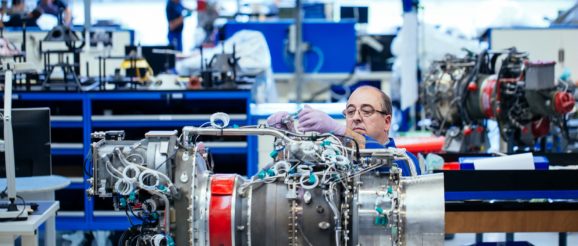Safran aiming to build on landmark year with innovation focus

Safran Helicopter Engines is hoping to build on a landmark 2019 that saw four engines certified with their successful entry into service in 2020.

The 1,300 horsepower Arrano, used in the Airbus H160, was certified in June 2019. According to Safran, compared with similar-sized engines, it has 15 percent less fuel consumption, and requires 40 percent less maintenance time.
The 2,500 to 3,000 horsepower Aneto was certified in December 2019.The engine is used in the Leonardo AW189K, with the first delivery of the variant to launch customer Gulf Helicopters expected in the second quarter of 2020.
Finally, two versions of the 1,400 to 2,000 horsepower Ardiden, the 1U (powering the HAL light utility helicopter) and WZ16 (Avicopter AC352), were certified in November and October, respectively.
“The next step is simply going to be the entry into service of several platforms that will be gains in terms of market share for Safran Helicopter Engines,” said Franck Saudo, the manufacturer’s chief executive officer, in a press conference held during HAI Heli-Expo 2020 in Anaheim, California. “Simply put, the H160 is a market segment [where] we are not present at the moment . . . [and] the AW189K is [in] another market segment where we were not present. Here again, entry into service will correspond with gains in market share.”
In terms of an overall market outlook, Saudo said Safran was remaining cautious. “I see a slow recovery scenario with a flat situation for the market in the short run, meaning one to two years,” he said. “We keep being optimistic about the medium- to long-term outlook of the market for a very simple reason, which is the fact that high-growth countries will equip in terms of helicopters in the coming years.”
He said the timing and pace of this growth in those countries – primarily China and India – remains to be seen.
To address future challenges, Safran has identified four key areas of focus: additive manufacturing, a desire to further optimize its current engine range, digital monitoring, and reduced carbon emissions.
Additive manufacturing, said Saudo, offered the potential to reduce production cost and improve engine performance through allowing new geometries that were unattainable by traditional manufacturing methods.
“This opens really a new space for our engineering teams, which is ‘Think differently simply because you have access to new geometries, and geometry can lead to further performance,’ ” he said.
Both the Arrano and Aneto have serial parts created through additive manufacturing, and in an engine demonstration test in September 2019, Safran redesigned its longstanding Arrius engine with 30 percent of its parts created by the process.
“We ran the engine on the test bench and it worked perfectly,” he said.
Another area of focus for Safran is to enhance the performance of its existing engines. Through optimized aerodynamics and materials, Saudo said he was confident the OEM can reduce fuel consumption in its existing line by 10 to 15 percent by 2030.
Further progress in developing Safran’s digital reach will allow the manufacturer to move from being reactive to preventative, said Saudo. The company launched its health monitoring service two years ago, which provided real-time access to its customers’ flight data. This data is then analyzed, and Safran provides maintenance recommendations according to the results. The service is now in use by 500 operators (out of a total customer base of 2,500), spanning 3,200 engines.
The final area of focus for Safran is to reduce greenhouse gases, which is a “top priority,” said Saudo. To achieve this, the company is working on two fronts: developing hybrid electric technology, and working on alternative fuels (including biofuel).
The engine manufacturer is a partner of Daher and Airbus on EcoPulse, a distributed hybrid propulsion aircraft demonstrator. It is also working on the Airbus Racer, which will serve as the demonstrator for Safran’s start-and-stop capability. The twin-engine helicopter will allow one engine to go “super idle” to reduce fuel consumption during cruise. That idle engine will have a hyper-fast restart capability to come back online if needed.
Safran Helicopter Engine’s efforts here are part of the wider Safran Group’s aim to reduce emissions by 50 percent by 2050.
Earlier this year, Bell announced it was dropping Safran as the propulsion system partner for its Nexus, following the airframer’s decision to use entirely electric, rather than a hybrid electric, system for its VTOL design.
Saudo said this was an indication of a variety of markets within the emerging VTOL sector, rather than hybrid not being a suitable approach. “I believe in the power of hybrid electric for VTOL, [but] there is also room for full electric,” he said. “Depending on the market segment, there is a natural sweet spot for full electric, but there is also a spot for electric hybrid. And simply put, it all depends on the length of missions in terms of minutes you want to fly or distance you want to fly: the shorter, the more full electric has potential.”
The post Safran aiming to build on landmark year with innovation focus appeared first on Vertical Magazine.
